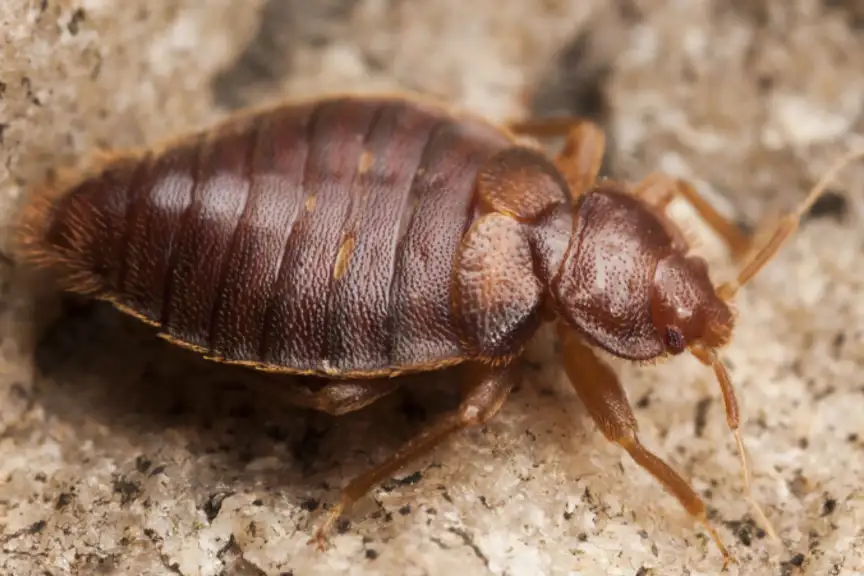Bed Bug Control in Your Home


Bed Bugs are an introduced pest which feed on the blood of warm-blooded animals, including humans! Bed Bugs feed on exposed areas of skin such as the face, neck, arms, feet and ankles. Bed Bugs can leave behind small red, itchy welts often with a lighter red coloured halo around the bite mark. In cases where there is a large patch of bites, this indicates many Bed Bugs were feeding at a time. In worse cases, bites can develop into blisters potentially leading to infection; can cause the area of skin to fall off; affect sleeping patterns and mental health; and trigger allergic reactions. Bites can take several days to develop, if a person is travelling to different accommodations over a period of days, it may be difficult to pinpoint the original place of infestation.
Although Bed Bugs are not known to transmit diseases, physical injuries and potential consequences to mental health are a great cause for concern. It's important to prevent Bed Bugs from entering the home so make the environment less favourable; vigilantly monitor; and act quickly and control at the first sign of infestation.
Bed Bugs are very small insects, adults are generally 4 – 6mm in length and can increase in size to 10mm after feeding and filling up with blood. Bed Bugs are flattened, heavily segmented and oval-shaped with a pointed rear (abdomen). Bed Bugs are generally a medium-brown to a darker reddish-brown.
At the front of the head are a pair of short, straight, backward facing antennae. At either side of the front of the head are two, dark-brown to red compound eyes. Underneath the front of the head is a needle-like mouthpart used for biting and feeding.
Behind the head is the first segment of the middle section (thorax) known as the pronotum. In Bed Bugs, this segment is a wide plate which curves slightly around the head and is covered in hairs.
On the underside of the middle section (thorax) of the body are three pairs of outward facing legs used for crawling. Bed Bugs do not have wings.
Bed Bugs prefer to live in groups and can be found throughout the year, mostly during the warmer weather. Bed Bugs are most active during the night and as they do not live on their host, they hide throughout the day. However, given the opportunity of a host, they can also be active during the day.
Bed Bugs can travel up to 30m after feeding but generally hide within 3m of a host. As Bed Bugs are not highly mobile creatures, they hitchhike from place to place either directly on animals or people; or on various moveable items.
Bed Bugs are attracted to elevated temperature and carbon dioxide created by warm-blooded animals. Bed Bugs also prefer dark red and black colours, so avoid using these colours in bedding.
Bed Bugs can secrete an oily substance from their abdomen which is foul yet sweetly smelling. This secretion is used as an alarm signal to other Bed Bugs.
After feeding on blood, females usually lay 2 – 5 eggs either individually or in clusters. Eggs are sticky to help them adhere to surfaces. A female generally lays 120 eggs in her lifetime of 250 days. Life expectancy can vary according to environment and species, with some Bed Bugs living up to one year. Eggs are cream-coloured, elongated and less than 1mm in length.
Juveniles (nymphs) are similar to adults only smaller in size and paler in colour, gradually growing through various stages into adulthood, shedding skins at each stage.
The needle-like mouthpart is used to pierce the skin of their host, inject saliva (which delivers an anaesthetic, prevents blood coagulation and blood vessel constriction) and suck out blood. This process can take up to 10 minutes without the awareness of the host. Prior to feeding, blood is sometimes regurgitated from the previous meal. This causes the classic signs of browny-black smears of dried blood on fabrics and surfaces.
Bed Bugs can generally survive a few months without feeding and in ideal conditions, up 6 months. While quarantining off a room with a Bed Bug infestation may help to prevent the spread of Bed Bugs, it is not an appropriate method of control as they can survive for long periods without food.
Bed Bugs can be found anywhere in close proximity to warm-blooded animals. Most prevalent infestations occur in high density living such as in apartments and city areas; and also in budget accommodation where rooms are not regularly monitored and maintained for pests. However, even the cleanest of places can still harbour Bed Bugs.
Bed Bugs can be found in the crevices, junctions and seams of fabric items and hard surfaces.
Cockroaches, spiders and centipedes, however these are not appropriate biological methods of control in the home.
Seek urgent medical aid if you are unsure what the patient has been bitten by or if symptoms worsen.
Bed Bug infestation cannot be identified purely based on the evidence of bites. Bites are nearly indistinguishable from other pest attacks such as those from spiders, fleas and mosquitoes.